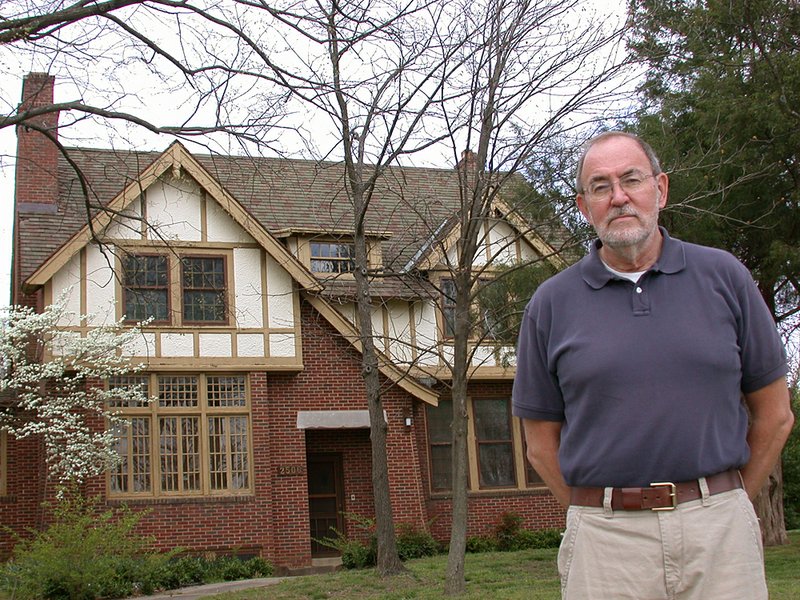JONESBORO — When Scott Darwin began teaching at Arkansas State University in 1969, he lived next door to the stately two-story house on Aggie Road that was once the home of ASU’s first president.
Darwin rented a small apartment on the second floor of a residence then owned by ASU engineering professor Henry Eldridge, and he often looked out at the neighboring Tudor-style brick home.
“It is a beautiful sight,” he said. “It’s a gem.”
More than four decades later, Darwin, who retired in 2008, is trying to save the Aggie Road home from demolition as ASU prepares to build four sorority houses there.
ASU officials said the structure, along with 18 smaller brick homes nearby that are owned by the university, are set to be torn down as soon as April.
Victor Cicero Kays built the Tudor home in 1936 during his 43-year tenure as ASU’s first president. He was recruited to lead the school in Jonesboro when the 37th Arkansas General Assembly created four agricultural schools in the state in 1909.
Kays kept the house after he stepped down as the university’s president. His family’s estate eventually sold the house and the lot to ASU in 2004.
Now, ASU officials’ plans to build four sorority houses for $8.2 million along Aggie Road have angered Darwin and others who want to preserve the historical value of the home.
“When ASU bought the property in 2004, I never in my wildest dreams imagined they’d tear it down,” Darwin said. “This home has historical significance. Kays turned [ASU] from an agricultural school to a state university.”
Others have joined the efforts to save the home.
Clyde Milner II, director of the ASU heritage studies doctoral program, fears that demolition of the home will tarnish the university’s reputation for preservation.
ASU has gained attention in its efforts to restore the boyhood home of singer Johnny Cash in Dyess and its conversion of a Piggott home where Ernest Hemingway once lived into a museum and a writers’ retreat.
“This will really look bad,” Milner said. “This is how universities create disasters. This will become a case study in preservation classes of what not to do.
“Kays is quite a noble, heroic person,” Milner said. “This could be turned around quickly and made into a winwin situation by saving the home and promoting it.”
Several people have written to the local newspaper, the Jonesboro Sun, in support of saving the home.
ASU interim Chancellor G. Daniel Howard said in a news release earlier this month that the four sorority houses, which will be home to 80 students, are set for completion in July 2013. Each 8,051-square-foot house will feature a Southern mansion style of architecture.
“It is clear that there is a demonstrated need for this type of housing,” Howard said in the release. “New sorority housing will enhance the living and learning environment of the university and will help additionally highly-qualified students.”
ASU System President Charles Welch said administrators have looked at the economic feasibility of keeping Kays’ home.
At first, officials suggested the home could be moved if anyone wanted to pay for it. But ASU had no takers, he said.
“I understand their arguments,” Welch said. “Those who want to save the home are passionate. But those who support the sororities are also very passionate.
“Most of our students now couldn’t tell you where the Kays’ home was,” he said. “It’s one of those things. You have to weigh the pros and cons.
“It’s not easy. We’ll do what makes the best sense for the university, and then we’ll move ahead.”
Last week, a drilling crew from Little Rock took soil samples around the Kays home to determine the ground’s stability for the sorority homes’ foundations.
The crew set up on the vacant lot where the home in which Darwin once lived stood. Years ago, that home had been converted into a fraternity house when Eldridge moved out, Darwin said.
“They made a shambles of the home, and it was torn down,” he said.
Plans the drilling crew had Tuesday showed four sorority houses along Aggie Road; the Kays home was not included.
“They’ve kept us in the dark about the plans,” Darwin said of ASU administrators. “They knew we’d raise a ruckus. They tried to keep it under wraps. Well, I unwrapped it.”
Milner suggested converting the Kays home into a guesthouse for dignitaries visiting ASU. Milner added, “This house is a distinct part of our history. This is the home of the man who has made this university exist.”
A house at Guilford College in Greensboro, N.C., where Milner’s uncle, Clyde Milner, once lived while serving as the college’s president, was converted into an alumni house.
Henderson State University in Arkadelphia, where Welch served as president before moving to Jonesboro in 2010, provides a guest home on campus. The University of Central Arkansas in Conway has guest housing as well.
Welch acknowledges that ASU preservation projects have drawn public interest, saying the Hemingway home has drawn thousands of visitors and that the Cash home, once opened, will also be a tourist attraction.
“I always want to look for ways to protect properties as much as possible,” the ASU System president said. “But the sorority houses guarantee revenues. We’ll recoup our expenses from [room and board] payments.”
Meanwhile, Darwin, Milner and others still hope the Kays house will be saved from the wrecking ball. They plan to continue drawing attention to the home and suggesting alternate plans to preserve it.
“I want to scream from the rooftops,” Darwin said. “We just had ASU’s 100-year celebration [in 2010]. How can we be so obtuse? How can we let this house go?”
Arkansas, Pages 13 on 03/25/2012
